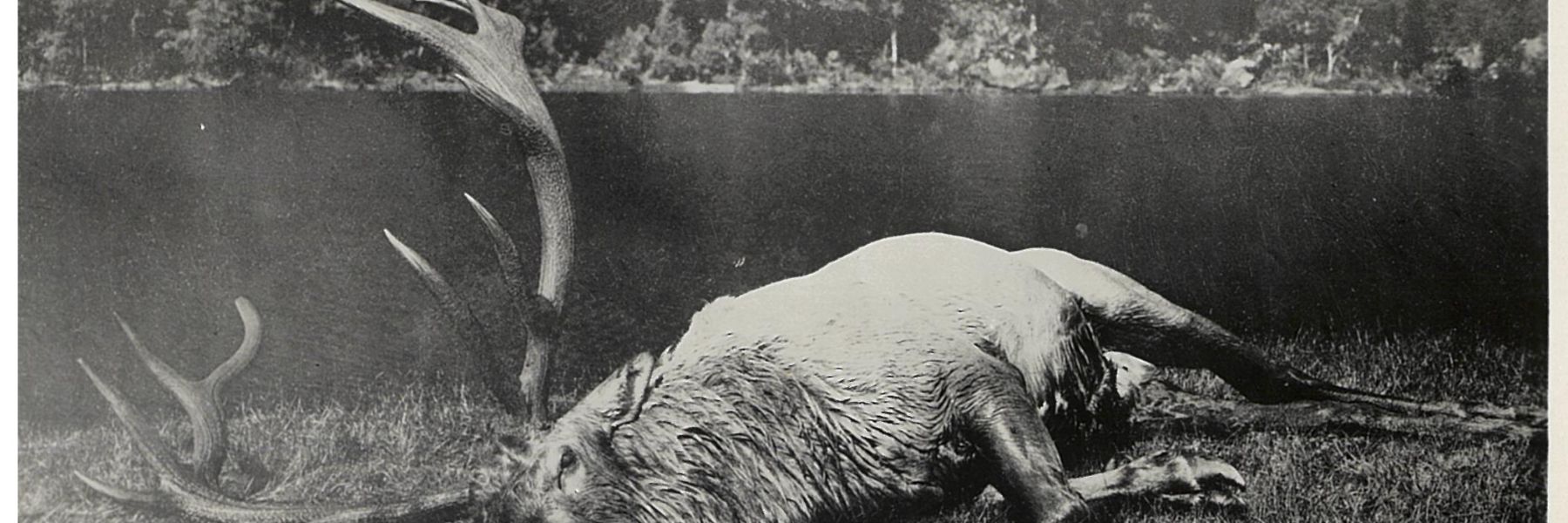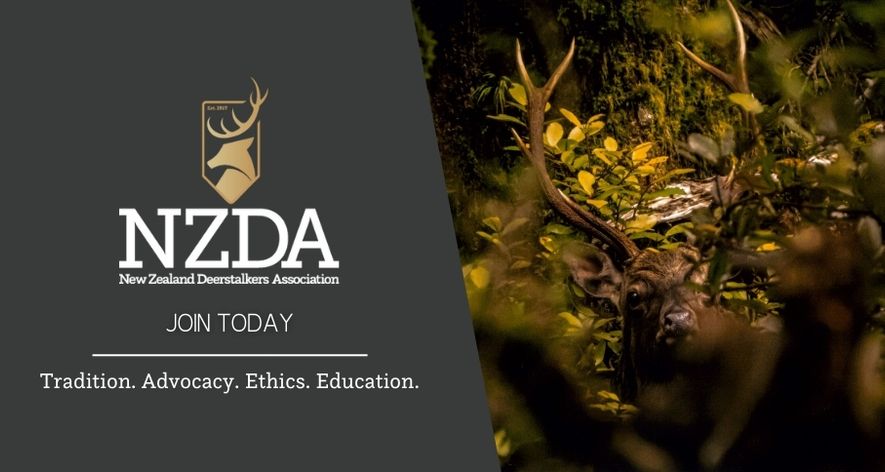28 August 2023
Hunting and Wildlife Magazine - Winter Issue 221
Words By: Simon Gibson
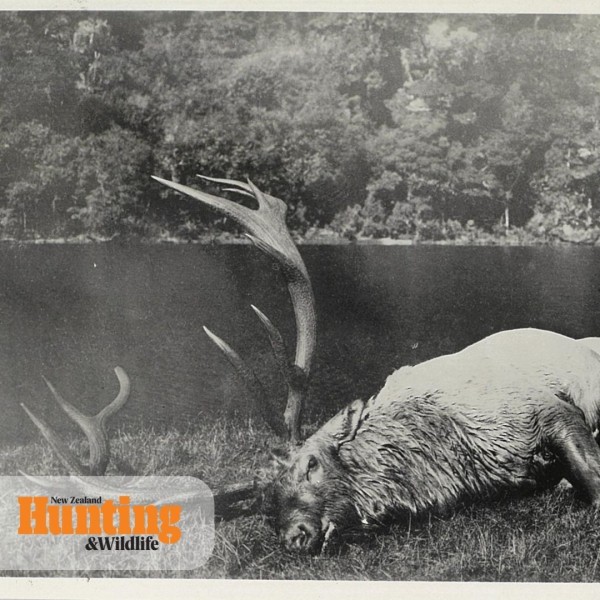
One of the most iconic wapiti hunting photos ever taken was that of Donald’s magnificent bull on the shores of Lake Katherine. 54¾ x 47¼, 14 points, DS 411¼.
The 11th of April 2023 marked the 100-year anniversary of the first licensed wapiti trophy being taken in New Zealand by well-known Waiarapa identity and hunter Vivian Donald on the shores of Lake Katherine in George Sound.
Vivian Donald was born in the Wairarapa on the 17th of July 1878. He was involved in the family business Donald and Sons in Masterton, makers of the famous Donald Wool Press with branches in Australia and South Africa. He eventually took the business over when his father retired. While he played many sports and excelled in competitive rifle shooting it was deerstalking that became his passion. He hunted the nearby Tararua Range and went on to hunt extensively throughout New Zealand and hunted in Africa.
Vivian Donald undertook his first trip to the South Island in 1919 where he spent several weeks in the lower Rakaia River. Large numbers of stags were looked over before he took the best head of the 1919 season with his .280 Ross rifle, a big even 16-pointer with a length of 42½ inches. In 1921 he returned to the South Island, this time making the extremely long trip from Masterton to the Lake Manapouri area in Southland. It was there that he met the Murrell brothers and stayed at their boarding house. Les Murrell was a well-known guide in the area and introduced Donald to the extensive areas around the lake that held a large population of red deer. A number of good trophies were taken, and he returned the following year with his daughter who took a number of good heads also. Hunting back then wasn’t a simple matter of heading bush wherever you wanted, you had to apply and pay for a hunting permit from the local Acclimatisation Society. Trips like this required weeks away from home and travel was often slow and arduous with the hiring of guides quite normal, so only those of some financial means could undertake them.
When the Prime Minister of the time, the Rt Hon W. F. Massey visited Invercargill in 1922, the Southland Acclimatisation asked that a wapiti hunting season be held in 1923 with two licences to be issued with a fee of £10 being charged for each. This was eventually agreed to and after keen competition the first licences to hunt wapiti in New Zealand were issued to Vivian Donald and Leslie Murrell. Fiordland was still a very remote area with large tracts of land unmapped. Travel into the Fiords was a difficult and expensive exercise, so Murrell’s knowledge of the area was essential for the pair to be successful.
The only way to get over the main range and into the Fiords was by foot or by boat from Bluff. Murrell had a route from the West Arm of Lake Manapouri which went over the Wilmot Pass, and he had cut a track down to Deep Cove in Doubtful Sound. Travelling this route was time consuming and very hard going but once at Deep Cove, the Murrell’s 36 foot launch the Constance was available there.
Donald and Murrell arrived at the head of George Sound on the 10th of April where they set up a camp. The following morning, they set off up Katherine Creek, eventually arriving at the bottom of Lake Katherine. Through their telescope they spotted a very good bull lying on a sandy beach at the head of the lake. After several hours of hard going around the side of the lake, negotiating steep bush covered bluffs, they managed to get within 350 yards of the bull. Donald decided to take him with his .280 Ross rifle which was dead on out to 400 yards. The shot was not affected by the breeze blowing up the lake and he took the bull cleanly. The trophy wapiti proved to be a cracker sporting 14 points, a length of 54¾ inches and spread of 47¼ inches and scored 411¼ DS. The photo Donald took of his downed bull on the shores of Lake Katherine is a classic and one of the most recognisable photos in New Zealand’s wapiti history. Then began one of the heaviest carry outs that the pair had ever experienced. In many cases they were forced to wade out into the lake, at times passing the head from one another to get around the numerous bluffs. On reaching the bottom of the lake they decided to go down Katherine Creek which meant crawling over and sliding down boulders to avoid carrying the huge antlers through the thick bush. They arrived at camp on the shores of George Sound just on dark.
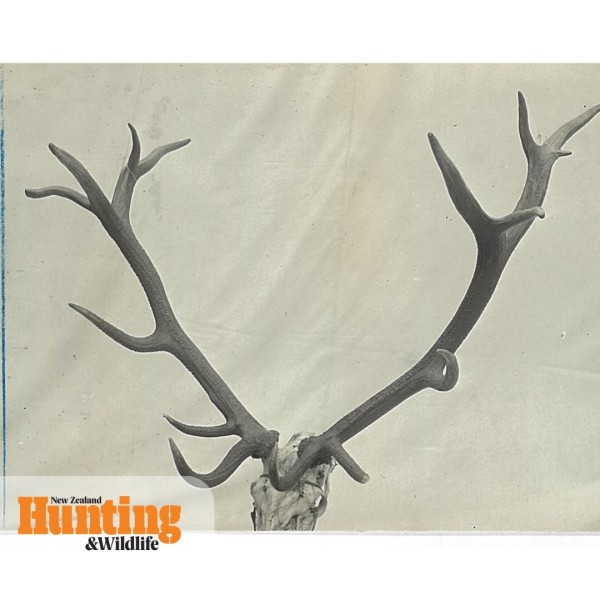
The second wapiti head shot under licence by Donald in Katherine Creek, 15pt, 53 x 37¾ inches.
After exploring the area around Lake Alice at the bottom of the Edith River and the Southwest Arm of George Sound where they found only limited sign of deer they returned to their camp. The following morning, they headed up Katherine Creek again and after a brief stalk on a bugling bull, Donald took his second wapiti trophy of the trip. The 15-pointer was lighter antlered than his first but still measured an impressive 53 inches in length.
Leaving George Sound behind them, they travelled around the coast to the head of Caswell Sound aboard Constance. Travelling on foot up the Stillwater River from the shores of Caswell Sound they soon reached the bottom of Lake Marchant into which the Stillwater and Large Burn rivers flow. After much discussion they travelled towards the left of the lake and shortly after a bull bugled nearby in thick bush. Donald’s shot didn’t put the bull down and it staggered into the river where it was finished off, ending up against a log on the far side. The bull was a younger animal and the antlers measured 48 inches in length with 11 points. Their permit allowed for the taking of two trophies with a third to be the property of the New Zealand Government, so the wapiti part of their permit had been filled but still allowed for the hunting of moose.
From Caswell Sound they travelled back to Deep Cove to replenish their supplies and then headed for Dusky Sound, arriving just on dark and staying on the launch. The following day they headed up the Seaforth River where they saw plentiful sign of moose but after four or five days of solid hunting realised that with the rut over and in such dense bush and with a limited number of moose being present they had little chance of taking a head on that trip.
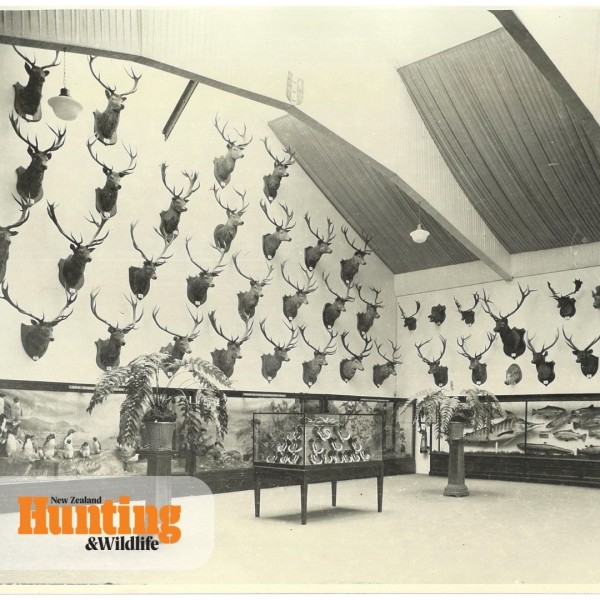
The 1924 Wembley Exhibition featured a magnificent collection of New Zealand shot heads. The second wapiti shot by Donald can be seen 4th from the right, middle row.
Vivian Donald and Les Murrell went on to take a number of trophy wapiti heads and many features of the area were named by them like the Stillwater River.
The British Empire Exhibition held at Wembley Park in 1924 showcased produce and manufactured goods, arts and crafts as well as historical artefacts from each of the Dominions, the Indian Empire as well as Britain’s African and Caribbean Colonies. A magnificent selection of New Zealand heads were on display to encourage wealthy sportspeople to head to New Zealand. Donald was asked by the British Embassy in Wellington to send two wapiti heads (the second and third he shot) to the exhibition. Both of these mounted heads were never returned home and have since disappeared.
References: Wapiti Hunting in New Zealand, Simon Gibson, 2013. Wapiti in New Zealand, D. Bruce Banwell, 1966. Hunting Legend – Vivian Donald, Kevin J. Whitelaw, 2023.

